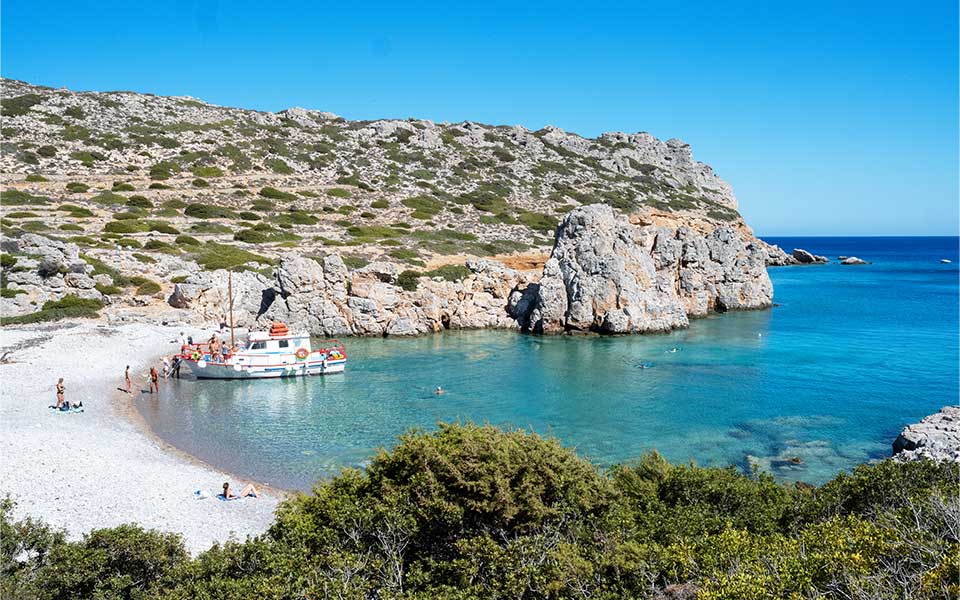Saria, this tiny island of 20.4 square kilometers just north of Karpathos, seems to contain everything – ancient monuments; stunning beaches; an impressive gorge; sea caves that shelter the Mediterranean monk seal and other caves that serve as nesting grounds for Eleonora’s falcons and rare long-legged buzzards; five chapels; some early Christian churches; and a nearly perfectly preserved medieval settlement at Palatia, believed to have once been a stronghold of Saracen pirates.
Our group of tourists and locals set off on Captain Nikos’ boat from Diafani in the morning, when the fog descending from Olympos enveloped the high mountain peaks whose steep cliffs, riddled with caves, serve as a refuge for Aegean gulls and wild pigeons. It felt as if we were sailing towards some mythical land, particularly when the entire boat entered the Tourkalas sea cave, with its incredible crystal-clear waters, and everyone took a dip in the sea. And suddenly, out in the open water again, a miracle occurred as dolphins accompanied us for a while! As we crossed the Saria Strait, the narrow channel which separates northern Karpathos from the islet of Saria, there appeared a breathtaking bay with shimmering emerald waters gently caressing the pebbles on the beach. The morning sun gilded the enormous boulders, perfectly interlocked and rising proudly among the wild grass and thorns, indifferent to the passage of time and the fury of the elements.
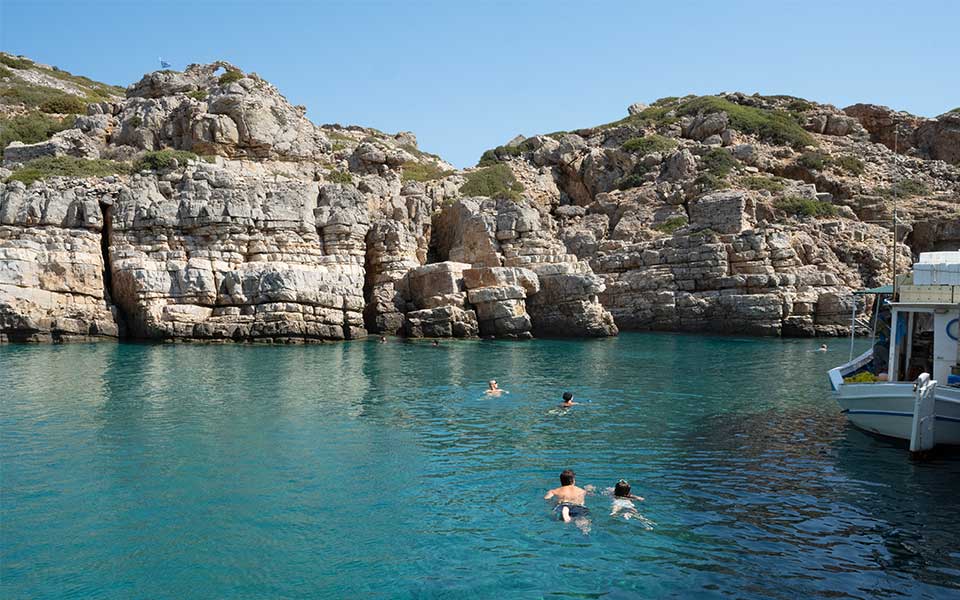
© Julia Klimi
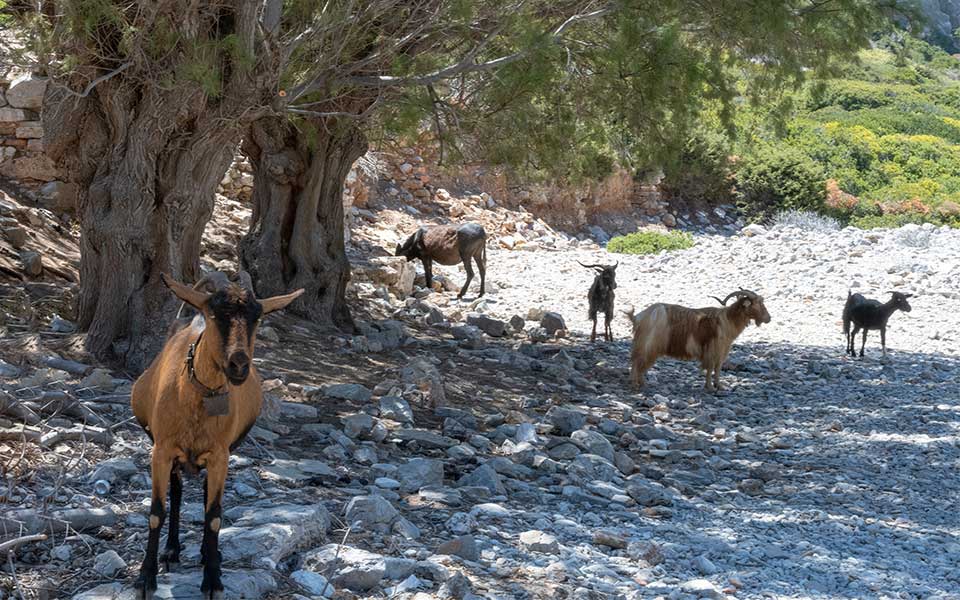
© Julia Klimi
Once on Saria, I climbed up to the ancient settlement of Palatia, clambering along with the sea on one side, and the gorge of the Entis River in the distance. On a peak above me, I spied the small chapel of Aghios Zaharias. I let my imagination travel centuries back to ancient Nisyros – the name given to Palatia by the geographer Strabo – which, along with three other cities on the island of Karpathos, formed the “Tetrapolis.” The town is mentioned in the tax lists of ancient Athens as one of the settlements on the island of Sarou, later known as Saria. From here, worshipers would depart by ship to the Temple of Poseidon Porthmios; from here, Radios, a priest from Nisyros, would leave to fulfill his high duties, as noted in an ancient inscription found in nearby Tristomo. The remains of vaulted structures around me, with their square bases and beehive-like domes, are remnants of an unknown civilization unique in the entire Aegean; similar structures can be found in ancient Assyrian sites, too, suggesting that the Saracens, who roamed the Aegean for centuries, used Palatia as a base.
These structures were inhabited for three centuries, until 961 AD, when the Byzantine general Nikephoros Phokas arrived with his naval forces. Saria had preserved some pre-Hellenic traces as well, as evidenced by a stone ax (Archaeological Museum of Cambridge) purchased by the British archaeologist R. M. Dawkins in Olympos, along with bronze tools from the Mycenaean era (currently at the British Museum).
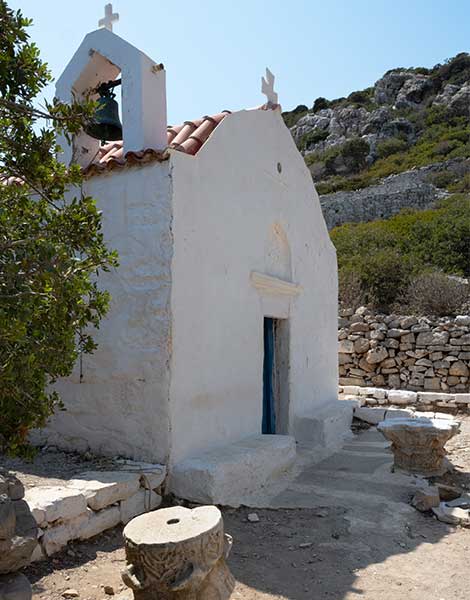
© Julia Klimi
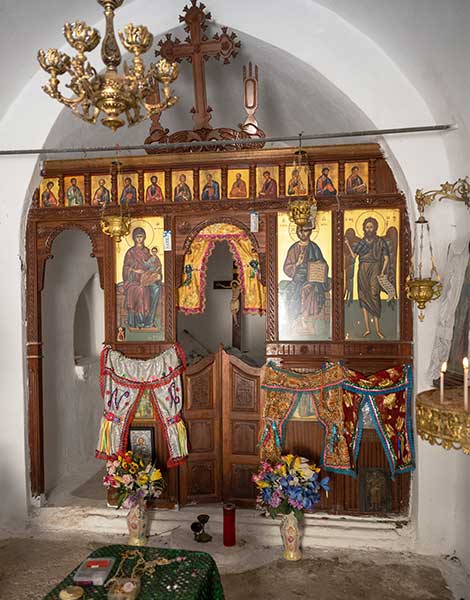
© Julia Klimi
The toponym “Argos” for the northern settlement on the island also bears witness to this more distant past. Those of us who were up for a further walk took the path through the gorge, accompanied by the tinkling bells of wandering goats, towards the ruins of that northern hamlet, a now-abandoned place with animal enclosures and threshing floors, testimony to its erstwhile role as an agricultural area for the residents of Olympos on Karpathos. Every year, they would gather their families and livestock, wade across the strait to the smaller island, and climb to find a few clearings in this wild land where they might sow and harvest their crops while grazing their animals.
Back at the impressive cove, a picturesque chapel and scattered ancient columns, capitals and a magnificent mosaic floor bore witness to the early Christian church (the Aghia Sofia Church) that once stood there. Along the Saria coastline, we swam in splendid sea caves. In one, the sun’s rays illuminated the interior just as a school of fish – in all likelihood parrotfish – appeared, while in another we exited by swimming underwater to emerge back in the majestic bay: an unbelievable experience! On the beach, we were treated to a delicious meat and fish barbecue, accompanied by salads prepared by Captain Nikos himself. We enjoyed our meal under the tamarisk trees, watched by wild goats lurking nearby. In the afternoon, back on the boat, our captain had yet another surprise in store; the boat motored into a fjord-like passage of emerald waters flanked by towering cliffs to arrive in a deep, sheltered bay boasting an exotic sand beach called Alimounda, for yet another unforgettable swim.
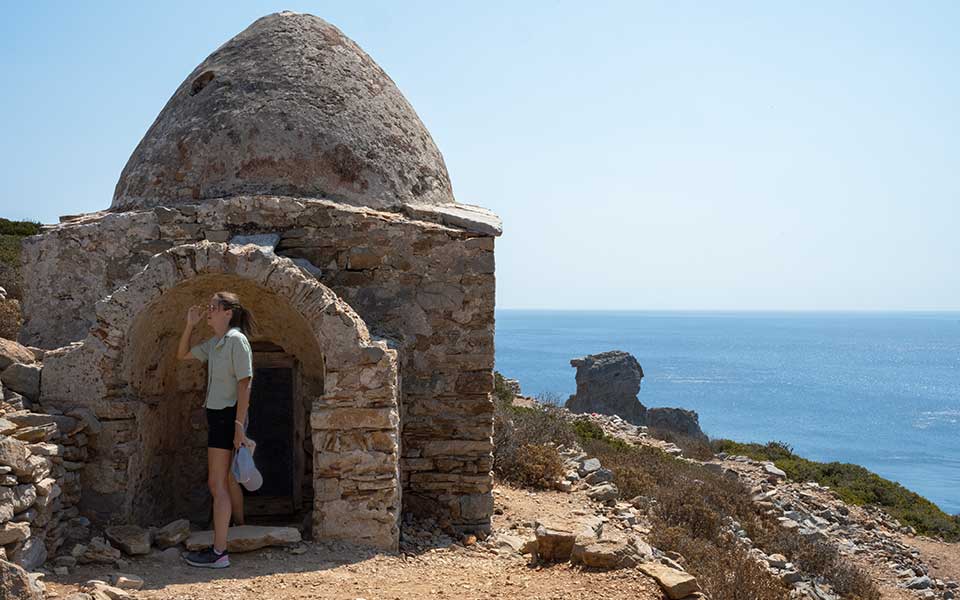
© Julia Klimi

© Julia Klimi
A Story from the Past
That evening, at Fillipakis’ café in Olympos, when I mentioned that we had visited Saria, I was told a wonderful story: “Once there was a shepherd named Minas who lived on Saria during the winter months. He had over a thousand animals. His mitato (cheese-making hut) and his animal enclosures were all inside the large cave of Arkeos. One day, a boat docked in the large bay, and six or seven armed Turko-Cretan pirates came ashore while the rest of the crew remained on board. The pirates climbed the slope, reached the cave, and found Minas alone, making cheese. His pregnant wife and two teenage sons were further up in the mountains with the animals. As soon as he saw that these strangers were armed, he understood their intentions. However, life had taught him to remain calm in such situations. He neither attempted to escape nor showed any panic; instead, he welcomed the men warmly. He was making cheese, and had a large cauldron on the fire. The pirates sat on the stone seats around the fire, leaving their weapons at the entrance. After all, what did they have to fear from someone they looked upon as an old man? (Minas was middle-aged, and they were much younger than him.) He offered them what was available in the hut, and pondered on what might happen. These men were clearly waiting for the animals to return from grazing so they could lead them to their boat and whisk them back to Crete. That would be a disaster; a herd so large took many years to acquire, and to lose it just like that? All these thoughts flooded his mind. What’s more, he knew that his pregnant wife might arrive at any moment and take fright at the sight of the weapons and the pirates. He had to do something. While they ate, he devised a daring plan. The cauldron on the fire contained the whey for making mizithra (a type of Greek cheese). He added more wood, and the fire blazed. When they asked what he was making, Minas replied, ‘Some very good cheese.’ The whey boiled away and, as he pretended to stir it, he poured some into a container, and then wheeled around and threw it at them. The burning sensation on their faces and in their eyes was excruciating. Except for one man who was only slightly scalded, the others fell down, writhing and blinded. The one who had avoided serious harm now bolted, running rapidly downhill; Minas grabbed one of the rifles and shot him before he could reach the boat to alert the others. The shepherd then put on all the bandoliers the pirates had been wearing and set off to find his family. From then on, Minas wore these cartridge belts (‘balaskes’ in Greek) as trophies, and that’s how he got the nickname ‘Balaskas,’ which eventually became the surname of his descendants.”

